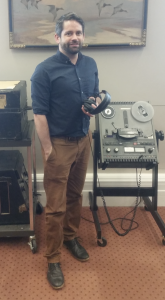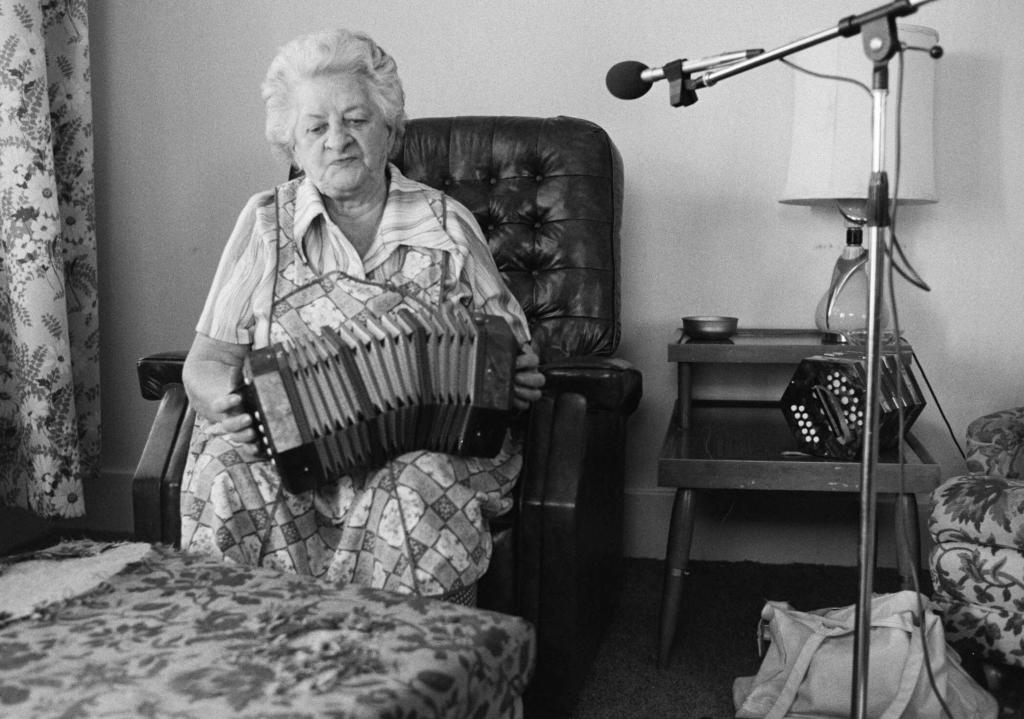Concertina player Mae Mulcahy, Butte, Montana, 1979. Montana Folklife Survey collection, American Folklife Center.
Patrick Egan (Pádraig Mac Aodhgáin) is a researcher and musician from Ireland, currently on a Fulbright Tech Impact scholarship at the Library. He recently submitted his PhD in digital humanities with ethnomusicology at University College Cork. Patrick’s interests have focused on ways to creatively use descriptive data from archival collections. He’ll present his project “Connections in Sound” on Aug. 29, at noon in room 119 of the Jefferson Building. There’ll be live music!

Patrick Egan, at the AFC. Photo: Steve Winnick.
You play Irish music but you make your living by researching it. Where did you grow up, and how did you get started?
I grew up in the foothills of the Wicklow mountains. I started playing Irish traditional music at seven years of age on the penny whistle, but my parents soon introduced me to the concertina, an instrument that has gained popularity in Ireland over the past 30 years. It also helped that there were Irish music sessiúns (jams) and concerts at my parents’ pub, Egans, every Saturday night. There, I developed an interest in music and the Irish language. It wasn’t my first language, but there are traces of it in our dialect of English. It was often spoken by some of my neighbors who came from an Irish speaking area in the west of Ireland called Connemara. I think the music and these neighbors influenced me a lot, and this interest later turned into research.
What’s the simplest definition of Irish traditional music? In 1855, a version of the melody that we now know as “Danny Boy” was published in “The Ancient Music of Ireland,” y the American sense of history, it’s been around a very long time.
“The Companion to Irish Traditional Music” states that tradition is known as “a body of melody, song and dance and associated activities that stylistically comes from the period before recorded music and radio.” Which essentially says that Irish music, song and dance is part of an oral culture, one that is predominantly shared person to person, and is not dependent on written or recorded sound.
Okay, but in the modern era, what makes a piece of Irish music “traditional”? If The Pogues, say, recorded a punk version of “Raglan Road” in the ‘80s, would that be “traditional”?
In the American Folklife Center there are a number of recordings like this which transcend genres and defy classification, which is quite fun, actually. For example, in some collections there are tunes and songs that could be strictly “traditional.” I am interested in both, but for my current research project I have been using an online resource for cross-referencing called www.irishtune.info. This site lists thousands of tracks of Irish traditional music and is a very useful tool for my research.

Harmonica player Pat Ford with his children and family, Shasta Valley, California, Sept. 3, 1939. W.P.A. California Folk Music Project collection, American Folklife Center.
The Library has more than a century of Irish music. At the Library, you’re looking to amass a digital database – the “items dataset” of the performers, instruments and stories used in those songs – so that they can be searched and cross-referenced. What do you hope that will tell us?
My research explores a large number of collections in the AFC using digital tools, so I am exploring what it means to use the latest technology to capture this data. It’s like taking the subject headings of “Irish American” away and experimenting with what happens when we allow collections to be explored by item level. This can reveal all sorts of information about the collections – what metadata (data about data) that we can use (or not) and how compatible collections can be with digital processing. Sometimes there is not enough data in these recordings or their accompanying notes to link them to other recordings, and sometimes the digital tool places limitations on the data because of the way that the digital technology is structured. My research explores these issues. Ultimately, this allows me to make more informed interpretations about both the material that resides in these collections and also the widespread impact of using digital tools.
You mention songs being “lost” in the collections, as when there’s a concert recording but not all the songs that are played are listed. Can you describe some of the finds you’ve made?
The concert and festival recordings that we discovered from the 1970s and 1980s have become an important part of the project. There are over 2,000 instances of tunes, songs, dances and stories from these festivals, which were organized at the peak of the folk revival. And because the songs are not listed, we discovered multiple versions of tunes, some rare songs and fascinating stories about the tunes that have never been described in the archive. For example, there is a concert performance of one of Ireland’s most famous artists, Christy Moore, from 1984. His set list was fascinating and it gives a snapshot of a key moment in his solo career. Other great finds have been artists such as Liz Carroll, John Vesey and Johnny McGreevy – these were all captured in the late 1970s to early 1980s. They make for priceless listening for Irish and Irish-American audiences in particular.
Lastly, your favorite songs in the Library’s collections.
There are so many great recordings, but some of my favorites:
* “The Monaghan Jig,” also known as “Scotch Mary,” by Patsy Touhey, recorded c. 1902-1904, from The Francis O’Neill Cylinders. The renowned “uileann” piper (Irish bagpipes) Patsy Touhey, showing tremendous skill. This track is part of a collection of some of the first Irish traditional music recordings made on wax cylinder.
* “Bold Jack Donohue” (also known as “The Wild Colonial Boy”) by Pat Ford, recorded in 1938, as part of the W.P.A. California Folk Music, at a time when there were few recordings of Irish music in the region.
* This interview with tunes by Gary Stanton with concertina player Mae Mulcahy, from 1979 in the Montana Folklife Survey.
Subscribe to the blog— it’s free! — and the largest library in world history will send cool stories straight to your inbox.
Subscribe to the blog— it’s free! — and the largest library in world history will send cool stories straight to your inbox.















